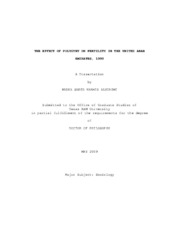| dc.description.abstract | An important question in the analysis of fertility is does the type of marital union matter? Is women's fertility affected by their marital union type? Does being in a monogamous or polygynous union have any effect on the number of children women will have? What is the nature of this difference? Does the social setting play a role? And, what kind of role does it have? Most studies, especially those based on African societies, where polygyny is most prevalent, note that female fertility is negatively associated with polygyny. This dissertation examines the polygyny-fertility relationship among married women in a different social setting, namely in an oil-rich country, that is, the United Arab Emirates. Using data from the 1999 National Family Survey for the Characteristics of the Native Households in the UAE, I was able to examine the effect of fertility using two statistical methods to model my dependent variables: Logistic Regression and Negative Binomial Regression.
My findings show that when controlling for numerous biological and social variables, polygyny has a positive effect on women?s current fertility, which is the likelihood of having a baby in the past 12 months, but a negative effect on women?s cumulative fertility, which is the children ever born to them. However, when the number of wives in the union was introduced into the models, polygyny effect on women?s current and cumulative fertility has disappeared, i.e., polygyny no longer has a significant effect on women?s fertility.
I discuss the implications of these findings for UAE national policy to increase the fertility of UAE women, an important consideration given that UAE nationals comprise only 20 percent of the UAE population in 2005. | en |


